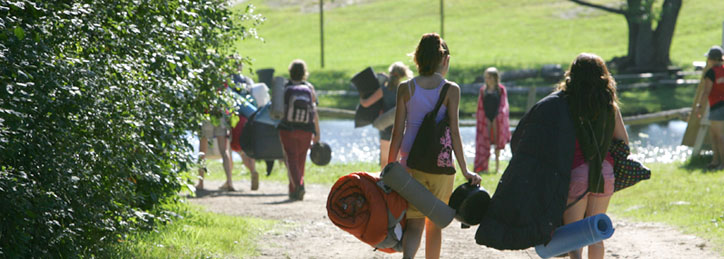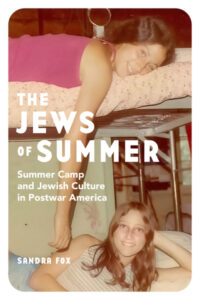Role-Playing Games at Jewish Summer Camps
An excerpt from The Jews of Summer: Summer Camp and Jewish Culture in Postwar America

(Summer camp. Image source: Ourkids.net)
The following excerpt comes from the book The Jews of Summer: Summer Camp and Jewish Culture in Postwar America by Sandra Fox (Stanford University Press, ©2023 by Sandra Felicia Fox. All Rights Reserved.) The book explores the role summer camps played among American Jews in the second half of the twentieth century.
This excerpt explores how Jewish summer camps used games to instill a positive sense of Jewish identity
***
In summer 1964, Camp Habonim Midwest, a socialist-Zionist camp in Michigan, held “four days and nites [sic] of special days,” each full of “enough excitement and drama” for an entire summer. After recounting a few challenging hikes, a counselor named Jackie described one special day, “Yom Hityashvut,” an elaborate, twenty-four-hour activity that turned a moment in Zionism’s history into an action-packed role-play. “The usual ruse,” wrote Jackie in her camp’s newspaper, began with a mock illegal immigration game, in which campers played “poor defenseless Jews trying to get to Israel” during the British Mandate. Counselors had roles too, playing the “British soldiers and dense Arab rabble-rousers” blocking the campers from their goal. Despite their originally “poor” position, the “Jews” made it “home, proceeding to build their kibbutz,” and after listening to “a wonderfully told tale of Israeli heroism,” the campers went to bed, waking up in the morning for more “building and carousing.” The game ultimately ended when the Jewish group won, “as they always do out here,” wrote Jackie. “A good time was had by all.”
 Starting in the 1960s, games centered on the history of Jewish migration to and settlement in Palestine emerged as common in Zionist camps. Thanks to educational guides for camping leaders, renditions of Hityashvut and similar games surrounding Jewish migration to Palestine also became widely circulated, with versions appearing in the programs of Reform, Conservative, and some communal camps growing in the decades after. Passed down from generation to generation, such games evolved into long-lasting traditions. Like Habonim, the camp of my childhood was a place where Zionism permeated nearly every element of daily life, even the precious time we got to spend cooling off at the pool. One day in summer 2002, counselors and lifeguards led my peers and me through a similar game, tasking us with “migrating to Palestine” by swimming to the other side of the pool. Only when we managed to swim past the counselors, representing “Arabs” and “British soldiers,” did we successfully reach our “homeland.” The pool was a different setting, and the focus was only on the act of immigration to Palestine rather than the settling of land that came afterward. And yet the nuts and bolts of the activity and its messaging were largely the same.
Starting in the 1960s, games centered on the history of Jewish migration to and settlement in Palestine emerged as common in Zionist camps. Thanks to educational guides for camping leaders, renditions of Hityashvut and similar games surrounding Jewish migration to Palestine also became widely circulated, with versions appearing in the programs of Reform, Conservative, and some communal camps growing in the decades after. Passed down from generation to generation, such games evolved into long-lasting traditions. Like Habonim, the camp of my childhood was a place where Zionism permeated nearly every element of daily life, even the precious time we got to spend cooling off at the pool. One day in summer 2002, counselors and lifeguards led my peers and me through a similar game, tasking us with “migrating to Palestine” by swimming to the other side of the pool. Only when we managed to swim past the counselors, representing “Arabs” and “British soldiers,” did we successfully reach our “homeland.” The pool was a different setting, and the focus was only on the act of immigration to Palestine rather than the settling of land that came afterward. And yet the nuts and bolts of the activity and its messaging were largely the same.
What explains the wide appeal and durability of games like Hityashvut and Aliyah Bet? The answer, on the one hand, stems from the trajectory of Israeli politics in aftermath of the Six Day-War. By having campers play as “poor defenseless Jews” of the Yishuv and identifying Palestinians as “rabble-rousers,” educators hoped to encourage identification with Zionism, especially as Israel’s new occupation of the West Bank brought about more scrutiny to the new state and its supporters. Elevating the story of Jewish settlement while overlooking Palestinian dispossession perpetuated an oversimplified notion of pre-1948 Zionism as a story of “good guys” and “bad guys,” with Jews always inhabiting the “good” side of the conflict. Games like Hityashvut became popular and widespread over the course of the late 1960s and 1970s because educators believed in their power to strengthen campers’ identification with Israel, particularly before they reached college campuses where the countercultural and youth-powered New Left might challenge their stances. By the time I played Aliyah Bet, the occupation’s continuation and the Second Intifada had only fueled more conflict on campuses over Israel, placing many Jewish students in the early 2000s in the position of needing to reevaluate, defend, or justify their relationships to Israel and Zionism. Part of what has helped these games endure, then, has been their utility as promoters of Zionist narratives. In a geopolitical conflict in which every term or designation is a potential land mine, role-playing communicates political messages almost wordlessly.
In this sense, these games’ lasting appeal has had less to do with the specific message they propagated than the broader power their creators and implementers believed they contained. Renditions of Hityashvut and Aliyah Bet were some of the earliest gamified historical scenarios that camps generated, but they were just two of the dozens of role-playing activities that Jewish camp counselors and educators created in the postwar period. Centering games on their visions of Jews from other times and places—primarily settlers of British Mandate Palestine, citizens and soldiers of Israel, or the Jews of pre-Holocaust Eastern Europe—camp leaders embraced play as a transformational source of Jewish authenticity, pride, and identity. Educators even infused color war competitions and all-camp festivals, the recreational highlights of the season, in comparable ways, inserting and imbuing their activities with their values, goals, and similar forms of creative dramatics. In all of these cases, play served goals far beyond educating campers with political or historical information. In fact, games like Hityashvut did not pass on data or detail very well at all, the physicality and dynamism of these activities often eclipsing the educational discussions or lectures that set them up beforehand. The former campers I spoke with often could not remember the historical particulars of the games they played: Were they role-playing migration to Palestine or the War of Independence? Were they simulating pogroms, the Holocaust, or an ahistorical conflation of the two? And yet perhaps in their very eschewing of nuance, these games produced emotions, mood, and feeling in spades, from excitement and joy to fear and distress. Through play, educators crucially hoped campers would come to feel more like the Jews they embodied and, in some crucial way, become more like them, assuming their values, passions, dreams, struggles, and even their pain.
In his 1961 book Man, Play, and Games, philosopher Roger Caillois wrote that “it is not absurd to try diagnosing a civilization in terms of the games that are especially popular there,” that “to a certain degree, a civilization and its content may be characterized by its games.” The concerns that motivated camp educators were in many ways unique to the Jewish postwar moment. Anxieties Jewish leaders held over growing affluence, suburbanization, and assimilation made themselves apparent in their camps’ language programs, Holocaust memorialization, and even their romantic and sexual cultures. The rise of educational Jewish camping occurred in a moment of pronounced concern over the future of Jewishness, over a perceived cultural decline in the face of postwar comfort. But considering how camps approached play helps reveals the hopes camp educators held about their work with youth and the kinds of Jews they held up as models of authenticity, with profound specificity. Following Caillois, this chapter analyzes the games camps played as a mode of “diagnosing” the anxieties that postwar American Jewish adults held about their present and toward identifying the fantasies they held about the Jewish future they could build within their summer camps.
Sandra Fox is the author of The Jews of Summer: Summer Camp and Jewish Culture in Postwar America.
***
Interested in more on this topic? Listen to episode 36 of the Revealer podcast: “Summer Camp and American Jews.”